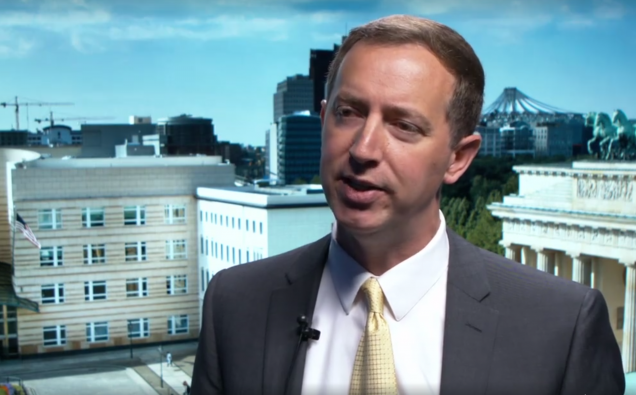
I first visited Luther College, situated in a small bucolic Iowa town in America’s heartland, in 2004.I had been invited to deliver a public lecture on Islam as the College’s first-ever high-profile Muslim speaker. My host was Professor Robert Shedinger, author of Jesus was a Muslim. The Iraq war had started and the fallout from 9/11 was still unfolding. Islamophobia was on the rise. But the College’s all-embracing Lutheran spirit filled the air and its senior scholars and leaders received me with the finest of Midwestern hospitality.
Thirteen years later, I had the privilege of returning the favor by welcoming Dr. Todd Green, one of Luther College’s most prominent scholars on Islam, to my office in Washington, D.C. Currently completing an assignment at the Department of State, where he is studying Islamophobia in Europe on behalf of the U.S. government, he presented me his most recent book, The Fear of Islam: An Introduction to Islamophobia in the West (Fortress Press 2015).
Dr Green’s study is a veritable guidebook to Islamophobia, taking a sophisticated, yet accessible approach to analyzing and explaining this toxic phenomenon. We learn how Islamophobia is propagated in the West today and how it negatively impacts everyday Muslims. We also learn about how Islamophobia has become a veritable industry with networks which are now global and backed by big money.
Green’s The Fear of Islam opens with an analysis of the Runnymede Trust report, Islamophobia: A Challenge For Us All (1997), for which I served as a Commissioner, and which established the term Islamophobia in the public discourse. Green then dives into the historical roots of Islamophobia and discusses how a series of recent events in the US and Europe have reawakened the beast of Islamophobia in Western society.
In the US, Islamophobia today can be tied directly to 9/11 and the shock of America being attacked on its own soil, as well as the subsequent War on Terror, writes Green. He argues that, in addition to the challenges posed by the 9/11 attacks themselves, the Bush administration propagated Islamophobic narratives to help build support for the War on Terror, which of course went on to wreak havoc on our part of the world.
Green postulates that Bush’s logical framework for intervening in the Muslim world to confront terrorism, which is also reflected in the 9/11 Commission Report (2004), argues thus: “Islam alone is what gives rise to the disease, so Islam alone must be the source of its cure. Since the United States lacks the means to ‘cure’ Islamist terrorism, all that it can do is fight it with unprecedented force.”
Contemporary Islamophobia in Europe, Green argues, finds its triggers not in the 9/11 attacks, but rather in a series of separate events. The Rushdie Affair, the Theo Van Gogh murder, the bombings in London and Madrid, and the Danish cartoon controversy, combined with both rising secularism and a growing Muslim population throughout Europe since World War II, have fed into heightened Islamophobic rhetoric. Today, Islamophobia runs rampant on the continent.
Green also discusses the distorting effects of the media in shaping Western conceptions of Islam. For instance, when the Western media does a story about Pakistan, the focus is often on violent extremists. But, as Green writes, “. . . By choosing not to air stories about Pakistani Muslims who fight for women’s rights or who provide health care to the poor, the network creates the impression that extremist or violent Muslims are the norm in Pakistan.”
Green sees the road ahead for countering Islamophobia as challenging. The negative impacts of Islamophobia have already set in for Muslims in the West, as their civil liberties have been curtailed and hate crimes against them have spiked. The War on Terror, meanwhile, has shredded societies in our own backyard. Not all hope is lost in Green’s eyes though for the Muslim community. He concludes the book with a series of interviews discussing how to confront Islamophobia. He also discusses the incredible outpouring of support emerging for the Muslim community in the West. However, he and his interviewees explain, Islamophobia can only be countered in the long run so long as people are speaking out against Islamophobia, countering misinformation about Muslims, and working to build bridges between Muslims and non-Muslims.
Green has had to face Islamophobia and the wrath of so-called “professional Islamophobes” head-on himself, even as a non-Muslim. He admitted that in this political climate, it is exhausting being a scholar on Islamophobia. The Islamophobes have even attacked his wife, crossing all sorts of personal and professional boundaries.
Green complains that there is a dropping off of liberal arts students and cutting of fund for their programs. However, he remains on the front lines fighting Islamophobia, even taking a group of students from Luther College to Europe every year to study Islam there.
I tried to cheer him up by saying next time he feels depressed about the attacks on him, he should think of Muslim scholars like me who face far more pressures than he can imagine.
May Dr.Green, driven by the Lutheran spirit that so warmly welcomed me to his Iowa campus thirteen years back, continue to resist the attacks of the Islamophobes and continue taking the lead in fighting Islamophobia and intolerance during these difficult times.















